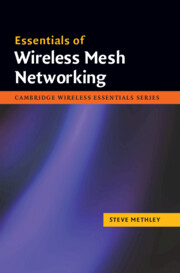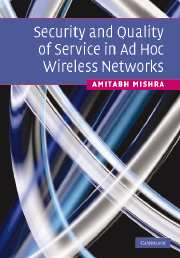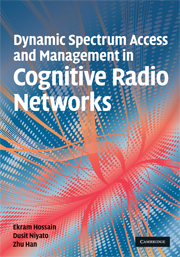Refine search
Actions for selected content:
3527 results in Wireless Communications
18 - Optimization of zero-padded systems
- from Part 2 - Transceiver optimization
-
- Book:
- Signal Processing and Optimization for Transceiver Systems
- Published online:
- 05 August 2011
- Print publication:
- 11 March 2010, pp 577-591
-
- Chapter
- Export citation
15 - Transceivers with orthonormal precoders
- from Part 2 - Transceiver optimization
-
- Book:
- Signal Processing and Optimization for Transceiver Systems
- Published online:
- 05 August 2011
- Print publication:
- 11 March 2010, pp 477-493
-
- Chapter
- Export citation
13 - MMSE transceivers without zero forcing
- from Part 2 - Transceiver optimization
-
- Book:
- Signal Processing and Optimization for Transceiver Systems
- Published online:
- 05 August 2011
- Print publication:
- 11 March 2010, pp 430-451
-
- Chapter
- Export citation
Appendix D - Properties of pseudocirculant matrices
- from Part 4 - Appendices
-
- Book:
- Signal Processing and Optimization for Transceiver Systems
- Published online:
- 05 August 2011
- Print publication:
- 11 March 2010, pp 771-778
-
- Chapter
- Export citation
Acronyms
-
- Book:
- Signal Processing and Optimization for Transceiver Systems
- Published online:
- 05 August 2011
- Print publication:
- 11 March 2010, pp 826-826
-
- Chapter
- Export citation
Frontmatter
-
- Book:
- Signal Processing and Optimization for Transceiver Systems
- Published online:
- 05 August 2011
- Print publication:
- 11 March 2010, pp i-viii
-
- Chapter
- Export citation
Part 1 - Communication fundamentals
-
- Book:
- Signal Processing and Optimization for Transceiver Systems
- Published online:
- 05 August 2011
- Print publication:
- 11 March 2010, pp -
-
- Chapter
- Export citation
10 - Single-input single-output transceiver optimization
- from Part 2 - Transceiver optimization
-
- Book:
- Signal Processing and Optimization for Transceiver Systems
- Published online:
- 05 August 2011
- Print publication:
- 11 March 2010, pp 332-369
-
- Chapter
- Export citation
16 - Minimization of error probability in transceivers
- from Part 2 - Transceiver optimization
-
- Book:
- Signal Processing and Optimization for Transceiver Systems
- Published online:
- 05 August 2011
- Print publication:
- 11 March 2010, pp 494-527
-
- Chapter
- Export citation
Appendix I - Transceiver optimization: summary and tables
- from Part 4 - Appendices
-
- Book:
- Signal Processing and Optimization for Transceiver Systems
- Published online:
- 05 August 2011
- Print publication:
- 11 March 2010, pp 812-824
-
- Chapter
- Export citation
22 - Optimization with equality and inequality constraints
- from Part 3 - Mathematical background
-
- Book:
- Signal Processing and Optimization for Transceiver Systems
- Published online:
- 05 August 2011
- Print publication:
- 11 March 2010, pp 730-749
-
- Chapter
- Export citation
2 - Review of basic ideas from digital communication
- from Part 1 - Communication fundamentals
-
- Book:
- Signal Processing and Optimization for Transceiver Systems
- Published online:
- 05 August 2011
- Print publication:
- 11 March 2010, pp 12-69
-
- Chapter
- Export citation
Appendix B - Matrices: a brief overview
- from Part 4 - Appendices
-
- Book:
- Signal Processing and Optimization for Transceiver Systems
- Published online:
- 05 August 2011
- Print publication:
- 11 March 2010, pp 753-765
-
- Chapter
- Export citation
3 - Digital communication systems and filter banks
- from Part 1 - Communication fundamentals
-
- Book:
- Signal Processing and Optimization for Transceiver Systems
- Published online:
- 05 August 2011
- Print publication:
- 11 March 2010, pp 70-112
-
- Chapter
- Export citation
21 - Convexity, Schur convexity and majorization theory
- from Part 3 - Mathematical background
-
- Book:
- Signal Processing and Optimization for Transceiver Systems
- Published online:
- 05 August 2011
- Print publication:
- 11 March 2010, pp 694-729
-
- Chapter
- Export citation
Preface
-
- Book:
- Signal Processing and Optimization for Transceiver Systems
- Published online:
- 05 August 2011
- Print publication:
- 11 March 2010, pp xvii-xvii
-
- Chapter
- Export citation
9 - History and outline
- from Part 2 - Transceiver optimization
-
- Book:
- Signal Processing and Optimization for Transceiver Systems
- Published online:
- 05 August 2011
- Print publication:
- 11 March 2010, pp 317-331
-
- Chapter
- Export citation

Essentials of Wireless Mesh Networking
-
- Published online:
- 01 March 2010
- Print publication:
- 30 April 2009

Security and Quality of Service in Ad Hoc Wireless Networks
-
- Published online:
- 26 February 2010
- Print publication:
- 06 March 2008

Dynamic Spectrum Access and Management in Cognitive Radio Networks
-
- Published online:
- 26 February 2010
- Print publication:
- 18 June 2009
